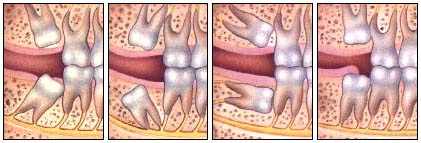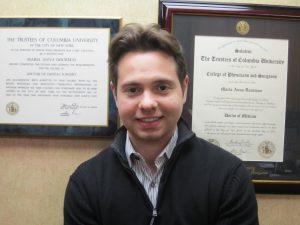Impacted Cuspid
A Wisdom tooth may grow toward your other teeth or away from them, or even in horizontal or vertical positions. When such conditions occur, it’s far simpler and less painful to have them removed early, before they have a chance to firmly anchor in your jaw as the teeth grow and the roots lengthen.
Not everyone has problems with their wisdom teeth. Factors that determine whether you will have problems include the size of your jaw and how your wisdom teeth grow in. There may be pain and swelling, or you may have no symptoms at all, even though the other teeth in your mouth may be at risk of damage. In addition to actual pain, common problems caused by wisdom teeth can include gum disease, crowding, decay, poor position, and cysts.
Since it is not practical for most people to evaluate how their wisdom teeth are developing, the best approach is to visit your dentist or an oral surgeon such as Dr. Ochs for an evaluation. He will review your dental history, take dental X-rays, and perform an examination to determine the general health of your mouth and the condition of your wisdom teeth. If a problem with your wisdom teeth is detected, he may recommend surgery to remove them and eliminate or avoid any unpleasant symptoms. Early removal is best for most patients, as it usually helps to avoid much more serious problems later on.
How and where your wisdom teeth are removed depends on several factors, including whether your wisdom teeth are erupted or impacted and how deep the roots are. Surgery may often be done in your dentist’s or oral surgeon’s office rather than in a surgical center or hospital. Your dentist or oral surgeon will review the recommended procedure with you so that you will fully understand and be comfortable with the procedure before it is done. You will also be given information about eating, medication, rest, driving, and other considerations before surgery as well as after.
After surgery, you will rest while under close observation as you recover from the anesthetic. You normally will be able to go home once your doctor is satisfied with your recovery.
The healing process begins immediately after surgery as your body sends blood to nourish the tooth socket. Simple pressure from a piece of gause is usually all that is needed to control the bleeding and to help a blood clot to form in the socket, which promotes healing. Within a day or two, soft tissue begins to fill in the socket, aided by the blood clot. Eventually, the bone surrounding the socket begins to grow, eventually filling in the socket completely, as illustrated here:

As your mouth heals, you can promote faster healing and avoid complications by simply following the care instructions that your dentist or oral surgeon will give you. While you may experience some discomfort as your mouth heals, following simple instructions will normally be all that is needed. However, you should call your doctor if you experience excessive bleeding or swelling, persistent and severe pain, fever, or any reaction to medications. A follow-up examination may also be scheduled to make sure that the socket is healing properly and that your mouth is returning to a normal, healthy state.
After years of procrastination, I finally decided to have all four of my wisdom teeth removed. I couldn”t be happier with the results. I completely recovered in four days and just in time for my 29th birthday!”
– Mr. A. Yesilevich

 After years of procrastination, I finally decided to have all four of my wisdom teeth removed. I couldn”t be happier with the results. I completely recovered in four days and just in time for my 29th birthday!”
After years of procrastination, I finally decided to have all four of my wisdom teeth removed. I couldn”t be happier with the results. I completely recovered in four days and just in time for my 29th birthday!”